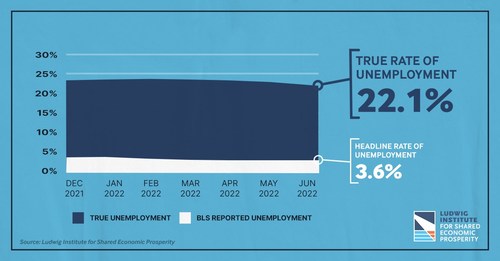‘Functional unemployment’ drops to lowest level in more than 25 years
Inflation-adjusted earnings remained steady for the second quarter of 2022 while the percentage of the American workforce finding full-time, living-wage jobs is at the highest level in 25 years, according to an analysis by the Ludwig Institute for Shared Economic Prosperity (LISEP).
“It is encouraging to see that even in the face of inflationary pressures, earnings for working families are holding steady with some modest gains, and meanwhile more Americans are moving into full-time, living-wage jobs,” said LISEP Chair Gene Ludwig. “We are hopeful that this trend will continue beyond the current inflationary cycle, ultimately lifting LMI families out of poverty and into a better quality of life.”
LISEP issued its monthly True Rate of Unemployment (TRU) for June in conjunction with the quarterly True Weekly Earnings (TWE) report for the second quarter of 2022. TRU is a measure of the functionally unemployed — the jobless, plus those seeking but unable to secure full-time employment paying above the poverty line. TWE is a measure of real median weekly earnings after adjusting for inflation, and differs from the data issued by the Bureau of Labor Statistics (BLS) through inclusion of all members of the workforce, including part-time workers and those actively seeking employment.
In LISEP’s latest TWE report, overall median weekly earnings remained unchanged over the first quarter of 2022 at $895 after adjusting for inflation. (These numbers, and all earnings numbers in this report, are recorded in inflation-adjusted 2022 Q2 dollars). Meanwhile, the percentage of workers seeking but unable to find a full-time, living-wage job – the “functionally unemployed,” as defined by TRU – plummeted nearly a full percentage point, from 23.0% to 22.1% – the lowest level since January 1995, the first year for which LISEP has calculated TRU.
By comparison, the BLS reported a drop in median earnings, from $1,063 to $1,041, and a steady official unemployment rate for June, holding at 3.6% for the fourth consecutive month.
The encouraging TRU report is tempered somewhat by the TRU Out of Population (TRU OOP) data, defined as the percentage of the total adult population (age 16 and older) who do not hold a full-time job, works part-time but desires full-time, and does not earn a wage paying above the poverty level. The TRU OOP only decreased by 0.5 percentage points, with the labor participation rate dropping by 0.1 percentage points, indicating that a small percentage of workers have dropped out of the labor force.
“This is a movement in the right direction,” Ludwig said. “We are cautiously optimistic that when inflationary pressures cool, this could spell some real gains for middle- and lower-income workers if this trend continues.”
Living-wage employment improved for most every major demographic, with the exception of Black workers, who saw a slight increase in functional unemployment, from 25.2% to 25.5%. Hispanic workers saw the biggest improvement at 1.9 percentage points, dropping from 27.1% to 25.2%, while White workers improved 0.4 percentage points, dropping from 21.1% to 20.7%. Both male and female workers saw improvement, down 1.5 percentage points to 17.7% and 0.5 percentage points to 26.9%, respectively.
Q2 weekly median wages as reported by TWE, while completely flat compared to Q1 at $895, saw some notable gains for lower income workers. The lowest quartile of earners was up $18 a week (3.3%), from $552 to $570. The upper decile of earners was also up, from $2,364 to $2,381, a 0.7% increase. However, this was offset by a decline in inflation-adjusted earnings for the third quartile of earners – representing the middle and upper-middle class – by 1.3%, dropping from $1,500 to $1,479.
Ludwig noted that while the overall report for both earnings and employment is encouraging, there remains room for improvement.
“This report represents some important improvement in terms of earnings and living-wage employment for lower-income workers, a trend that must be sustained if we are to continue along the path of an equitable economic recovery,” Ludwig said. “Of course the rising costs for necessities will continue to be a factor in maintaining this trend, so we can only hope that policymakers will take measures to blunt inflation without killing jobs and wages.”
LISEP issued the white paper “Measuring Better: Development of ‘True Rate of Unemployment’ Data as the Basis for Social and Economic Policy” upon announcing the new statistical measure in October 2020. The paper and methodology can be viewed here. LISEP issues TRU one to two weeks following the release of the BLS unemployment report, which occurs on the first Friday of each month. The TRU rate and supporting data are available on the LISEP website at https://www.lisep.org/tru.
LISEP issues the TWE quarterly following the release of the BLS Median Weekly Earnings report. The full white paper, “Understanding the Status of American Workers Through Analysis of Current Population Data,” can be viewed here. The TWE rate and supporting data are available on the LISEP website at https://www.lisep.org/earnings.
The Ludwig Institute for Shared Economic Prosperity (LISEP) was created in 2019 by Ludwig and his wife, Dr. Carol Ludwig. The mission of LISEP is to improve the economic well-being of middle- and lower-income Americans through research and education, and seeks to advance the dialogue around policy solutions to improve the well-being of all Americans.
In addition to his role as LISEP chair, Gene Ludwig is founder of the Promontory family of companies and Canapi LLC, a financial technology venture fund. He is the CEO of Promontory MortgagePath, a technology-based mortgage fulfillment and solutions company. Ludwig is the former vice chairman and senior control officer of Bankers Trust New York Corp., and served as the U.S. Comptroller of the Currency from 1993 to 1998. He is also author of the book The Vanishing American Dream, which investigates the economic challenges facing low- and middle-income Americans. On Twitter: @geneludwig.
SOURCE Ludwig Institute for Shared Economic Prosperity
